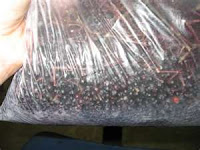Scientists at the University of Pennsylvania and the Monell Chemical Senses Center in Philadelphia have found that exposure to male perspiration has marked psychological and physiological effects on women: It can brighten women's moods, reducing tension and increasing relaxation, and also has a direct effect on the release of luteinizing hormone, which affects the length and timing of the menstrual cycle.
The results will be published in June in the journal Biology of Reproduction and currently appear on the journal's Web site.
"It has long been recognized that female pheromones can affect the menstrual cycles of other women," said George Preti, a member of the Monell Center and adjunct professor of dermatology in Penn's School of Medicine. "These findings are the first to document mood and neuroendocrine effects of male pheromones on females."
In a study led by Preti and colleague Charles J. Wysocki, extracts from the underarms of male volunteers were applied to the upper lip of 18 women ages 25 to 45. During the six hours of exposure to the compound, the women were asked to rate their mood using a fixed scale.
"Much to our surprise, the women reported feeling less tense and more relaxed during exposure to the male extract," said Wysocki, a member of the Monell Center and adjunct professor of animal biology in Penn's School of Veterinary Medicine. "This suggests that there may be much more going on in social settings like singles bars than meets the eye."
After the women's exposure to the underarm extract, further testing revealed a shift in blood levels of luteinizing hormone. Levels of this reproductive hormone, produced in pulses by the pituitary gland, typically surge right before ovulation but also experience hundreds of smaller peaks throughout the menstrual cycle.
Preti and Wysocki found that application of male underarm secretions hastened onset of these smaller pulses. Duration to the next pulse of luteinizing hormone was shortened by an average 20 percent, from 59 to 47 minutes.
Preti and Wysocki are now looking at the several dozen individual compounds that make up male perspiration to determine which may be responsible for the effects they observed. They also plan to study whether female pheromones can affect men's moods or physiological functions.
"This may open the door to pharmacological approaches to manage onset of ovulation or the effects of premenstrual syndrome or even natural products to aid relaxation," Wysocki said. "By determining how pheromones impact mood and endocrine response, we might be able to build a better male odor: molecules that more effectively manipulate the effects we observed."
The underarm extracts used in the study came from men who bathed with fragrance-free soap and refrained from deodorant use for four weeks. The extracts were blended to avoid reactions to individual men's odors. None of the women involved in the study discerned that male sweat had been applied right under their noses; some believed they were involved in a study of alcohol, perfume or even lemon floor wax.
Half the women received three applications of the male secretions during a six-hour period, followed three controlled exposures to ethanol, used as a control substance, over a six-hour period. For the other half, the regimen was reversed. The women did not report feeling any more or less energetic, sensuous, tired, calm, sexy, anxious, fatigued or active after exposure to male perspiration.
Preti and Wysocki are joined in the Biology of Reproduction paper by co-authors Kurt T. Barnhart and Steven J. Sondheimer of Penn's Department of Obstetrics and Gynecology and James J. Leyden of Penn's Department of Dermatology. Their work is sponsored by the National Institutes of Health.
SOURCE:
Biology of Reproduction, June 2003. News release, University of Pennsylvania.
Carter, C. Sue. "Hormonal Influences on Human Sexual Behavior," Behavioral Endocrinology (MIT, 1992, 0-262-02342-3), p. 134
Nelson, Randy J. An Introduction to Behavioral Endocrinology, Second Edition (Sinauer Associates, 2000, ISBN 0878936165), p. 250
Kary, Tiffany. "Crying Over Spilled Semen," Psychology Today, September/October 2002, p. 24.
Moir, A. Jessel, D. Brain Sex: The Real Difference Between Men & Women (Delta, 1989, ISBN 0-385-31183-4), p. 44.
SOURCE:
Biology of Reproduction, June 2003. News release, University of Pennsylvania.
Carter, C. Sue. "Hormonal Influences on Human Sexual Behavior," Behavioral Endocrinology (MIT, 1992, 0-262-02342-3), p. 134
Nelson, Randy J. An Introduction to Behavioral Endocrinology, Second Edition (Sinauer Associates, 2000, ISBN 0878936165), p. 250
Kary, Tiffany. "Crying Over Spilled Semen," Psychology Today, September/October 2002, p. 24.
Moir, A. Jessel, D. Brain Sex: The Real Difference Between Men & Women (Delta, 1989, ISBN 0-385-31183-4), p. 44.














